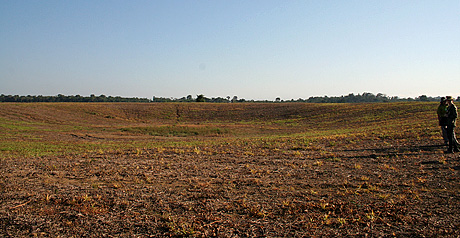 The pre-Columbian Indian societies that once lived in the Amazon rainforests may have been much larger than researchers previously realized. Archaeologists have located the remains of about 90 settlements in an area south of the city of Santarm, Brazil.
The pre-Columbian Indian societies that once lived in the Amazon rainforests may have been much larger than researchers previously realized. Archaeologists have located the remains of about 90 settlements in an area south of the city of Santarm, Brazil.
Traditionally archaeologists have thought that these inland areas in northern Brazil were sparsely populated before the arrival of the Europeans in the 16th and 17th centuries. One reason for this assumption is that the soil found in the Santarm area is generally quite infertile; another reason is that far away from all the major watercourses, the access to water in the region is poor during dry periods. It has therefore been something of a mystery that the earliest historical account from the Spaniard Francisco de Orellanas journey along the River Amazon in 1541-42 depicted the Amazon as a densely populated region with what the Spanish described as towns, situated not only along the river itself, but also inland.
The most surprising thing is that many of these settlements are a long way from rivers, and are located in rainforest areas that extremely sparsely populated today, says Per Stenborg from the University of Gothenburg’s Department of Historical Studies, who led the Swedish part of the archaeological investigations.
Together with Brazilian colleagues, the archaeologists from the University of Gothenburg have come across areas of very fertile soil scattered around the otherwise infertile land. These soils, known by there Portuguese name as Terra Preta do Indio, or Amazonian Dark Earth, areanthropogenic soilsnot natural occuring, butmodified by long-term human activity such as irrigation and waste disposal (wikipedia has a great overview here).
The results of this summer’s fieldwork also imply the Amerindian populations in this part of the Amazon had developed a way to overcome the environmental limitations by construction massive reservoirs.
Just as importantly, we found round depressions in the landscape, some as big as a hundred metres in diameter, by several of the larger settlements, says Stenborg. These could be the remains of water reservoirs, built to secure water supply during dry periods.
The archaeological investigations near the city of Santarm in between the Amazon mainstream and its tributary, the Rio Tapajs are considered to be extremely urgent. The ancient sites in the Santarm area are threatened by intense exploitation. With agriculture constantly expanding and the steady construction of roads, progress is rapidly destroying the archaeological evidence.
Our work here is a race against time in order to obtain archaeological field data enabling us to save information about the pre-Columbian societies that once existed in this area, before the archaeological record has been irretrievably lost as a result of the present development, states Mrcio Amaral-Lima, archaeologist atSantarm’sFundao de Amparo e Desenvolvimento da Pesquisa, in Santarm.